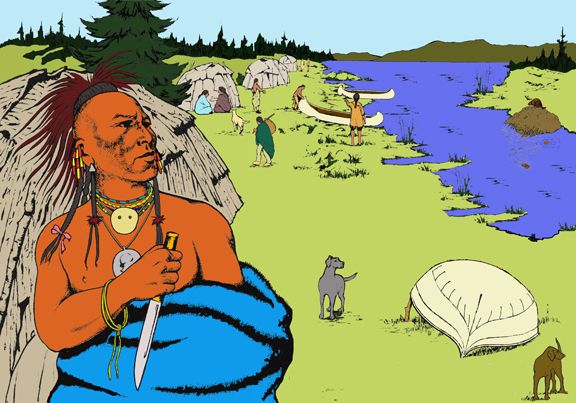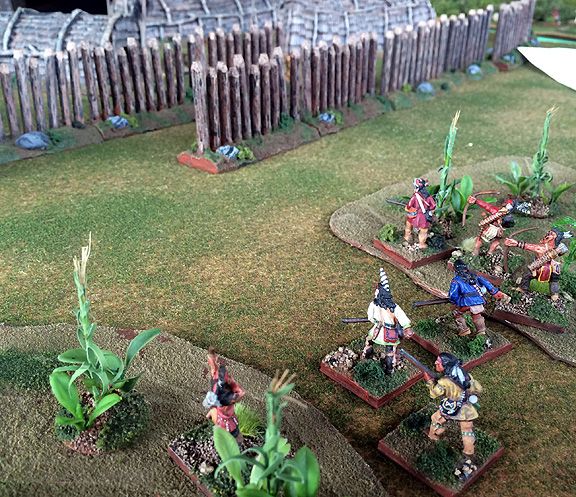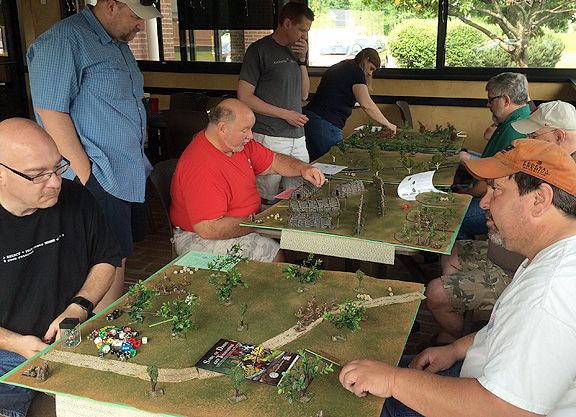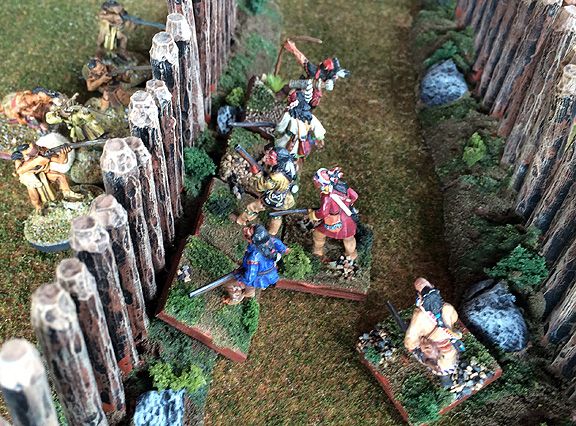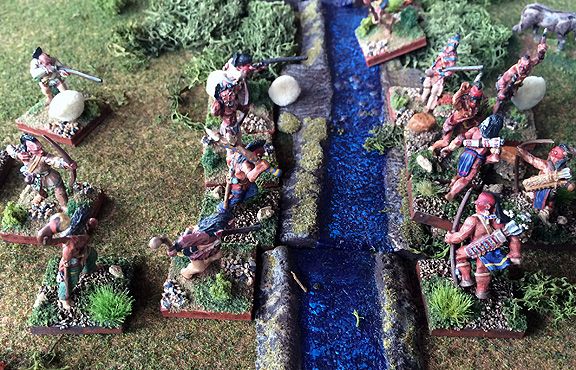 |
| Attack at the Portage was my scenario for this round, and saw my Erie hunters spread out carrying our canoe and bundles of goods past a section of rapids |
After the cards were played and the order set, here were the declared attacks this turn:
Mohawk attacked the Neutrals, rolling “The Creek Runs Red” (War vs. War #3)
Seneca attack the Shawnee rolling “Rescue the Captives” (War vs. Hunt #6)
Honniasont attacked the Erie, rolling “Attack at the Portage” (War vs. Hunt #3)
Kickapoo attacked the Miami, rolling “Give Them Time” (War vs. Hunt #1)
To read the account written by Keith covering his Neutral tribe's battle against the Mohawk, visit his Game Reports page.
With an odd number of players, as GM (and Erie tribal chief) I sit out some of the turns. However, this turn the Susquehannock player was feeling under the weather on the morning of our meeting, so I substituted in for him. I was actually happy that I got a chance to play the "Attack at the Portage" scenario, because I think it is tactically a very interesting game.
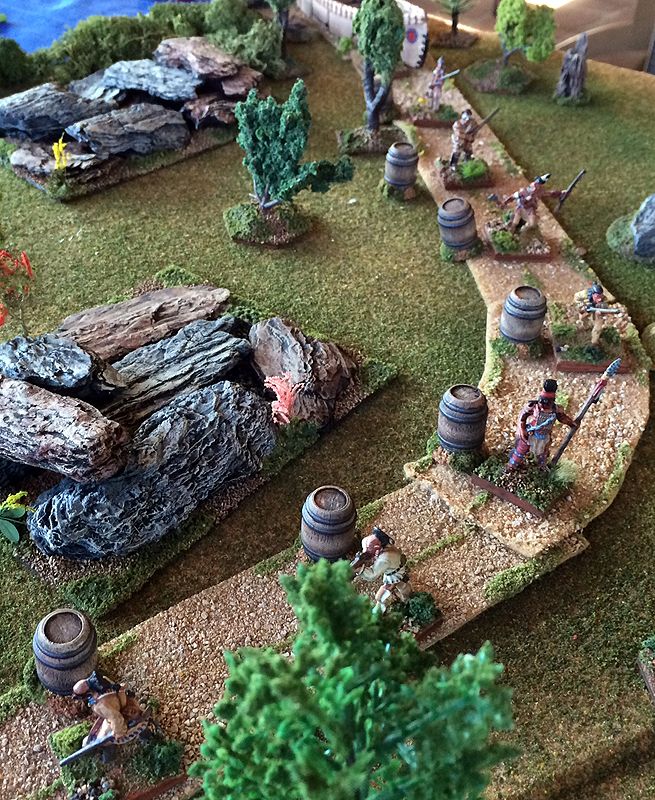 |
| My battle plan would be to have my Erie hunters carry their bundles to the rocky outcrop, left center. We would deposit them there, and consolidate to make our stand against the Honniasont |
Why was I expecting a melee rather than a shooting match? Well, Bruce -- who plays the Honniasont -- has hit on a favorite tactic of maxing out his troop list with Youths. He seeks to overwhelm the enemy with numbers. He's had mixed success with the tactic, but is having fun tweaking it to see how he can make it work better. So, my 10 Erie would face a force of 17 Honniasont (1 Chieftain, 16 Youths). It provides for some interesting, though a slight bit longer, games. The key to me is to try to pick off his Chieftain so you can force a morale check. The Youths all have the Wavering trait, which means they should begin to flee fairly quickly once he's gone. Otherwise, it can be a long and dangerous process wearing them down to 9 losses (more than 50% is the point where you check morale if your leader has not died).
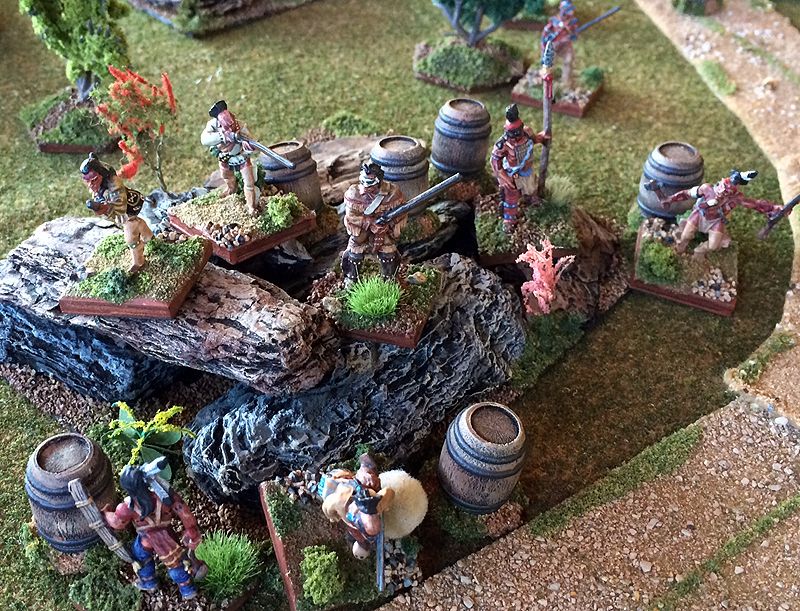 |
| My troops have almost all made it to the rocky outcrop. Note the warrior with wooden armor holding the spear on the right side of the rock |
My battle plan was to have all of my men move to a rocky outcrop inside the bend of the road. We would drop our bundles there, and consolidate against the more numerous Honniasont. My command rolls on my first turn were abysmal. I think out of 14 die rolls I scored no rolls above a "3" -- not a great start! The Honniasont had split their forces into one advancing from my right and another blocking the trail ahead. My rolls improved enough that slowly, my men moved to the rocky outcrop, put down their loads, and readied their weapons. The Honniasont also began to take shots, and edged closer. He began to rush in Youths, attempting to gang up on my Warriors and force an even-up or roll at an advantage.
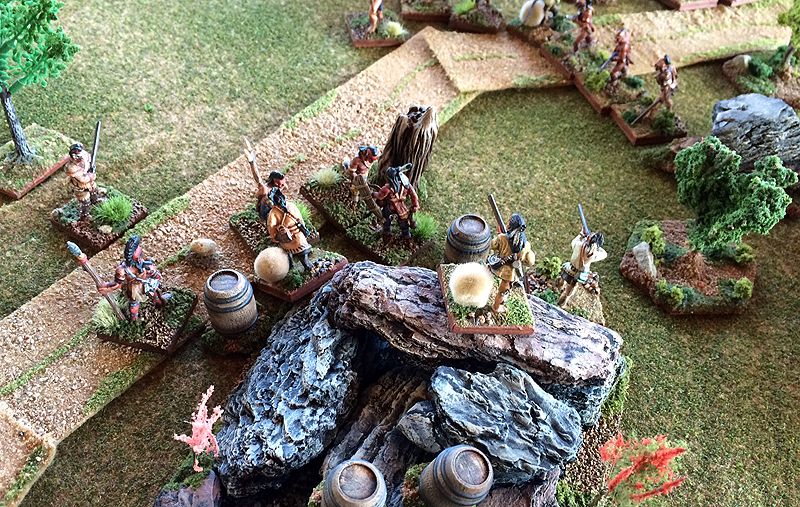 |
| And here they come! The Honniasont Youths begin to throw themselves against my Warriors (two are in contact in the center of the picture, while another line advances from the top) |
 |
| What our enemies saw -- the view from the woods as Honniasont Youths work up the nerve to assault my troops clustered around the rocky outcrop |
As it played out, Turn 8 belonged to the Defender. All four attackers lost. Sadly, for the middle pack who'd initiated the attack on the leaders, they failed. The Neutrals and the Shawnee entered the turn tied for the lead. Both scored major victories -- the Neutrals over the Mohawk and the Shawnee over the Seneca. On the remaining battlefield, the bitter foes the Miami and Kickapoo met again, with the Miami getting the upper hand, again.
 |
| One of the other scenarios: At top left, Shawnee braves pursue a force of Seneca who have raided their town and taken some women and children captive |
Here is the score in the campaign, so far. The Shawnee have edged out in front of the Neutrals! The Mohawk, despite their loss on the battlefield this turn, remain in close contention for the lead. We'll see next month if that means the two front-runners will face off, or if they will continue to fight off attacks of the other tribes.
Tribe
|
Place
|
Victory Points
|
Shawnee
|
1st
|
26.5 points
|
Neutrals
|
2nd
|
23.5 points
|
Mohawk
|
3rd
|
21.5 points
|
Kickapoo
|
Tied 4th
|
14 points
|
Seneca
|
Tied 4th
|
14 points
|
Miami
|
6th
|
13.5 points
|
Erie
|
7th
|
10 points
|
Susqehannock
|
8th
|
9 points
|
Honniasont
|
9th
|
3 points
|
The victory points come from three categories. First, Prestige Points (PPs), which come from battlefield success:
Tribe
|
Prestige Points (PPs)
|
Neutrals (Keith Finn)
|
19 (6 MajV, 1 MinD)
|
Shawnee (Joe Merz)
|
19 (4 MajV, 3 MinV, 1 MinD)
|
Mohawk (Dave Welch)
|
12 (3 MajV, 1 MinV, 1 MinD)
|
Seneca (Mike Stelzer)
|
12 (2 MajV, 3 MinV)
|
Miami (Jenny Torbett)
|
11 (2 MajV, 2 MinV, 1 MinD)
|
Kickapoo (Andy Swingle)
|
10 (3 MajV, 1 MinD)
|
Erie (Mike Demana)
|
8 (2 MajV, 2 MinD)
|
Susquehannock (Steve Phallen)
|
5 (1 MajV, 2 MinD)
|
Honniasont (Bruce Adamczak)
|
3 (1 MinV, 1 MinD)
|
Next, is SVPs, or Scenario Victory Points, which come (unsurprisingly) from fulfilling your objectives in the scenarios you play in:
Tribe
|
Scenario Victory Points (SVPs)
|
Shawnee (Joe Merz)
|
107
|
Neutrals (Keith Finn)
|
106
|
Mohawk (Dave Welch)
|
82
|
Seneca (Mike Stelzer)
|
80
|
Miami (Jenny Torbett)
|
80
|
Kickapoo (Andy Swingle)
|
68
|
Erie (Mike Demana)
|
65
|
Susquehannock (Steve Phallen)
|
60
|
Honniasont (Bruce Adamczak)
|
33
|
And finally, the Beaver Pelts. The higher value "Hunt" cards you play, the more pelts you collect. This also translates into the more Firearms upgrades you obtain for each battle (those Europeans will give matchlocks for quality beaver pelts).
Tribe
|
Beaver Pelts
|
Shawnee (Joe Merz)
|
45
|
Mohawk (Dave Welch)
|
43
|
Neutrals (Keith Finn)
|
41
|
Kickapoo (Andy Swingle)
|
36
|
Susquehannock (Steve Phallen)
|
32
|
Erie (Mike Demana)
|
31
|
Miami (Jenny Torbett)
|
29
|
Seneca (Mike Stelzer)
|
23
|
Honniasont (Bruce Adamczak)
|
22
|
